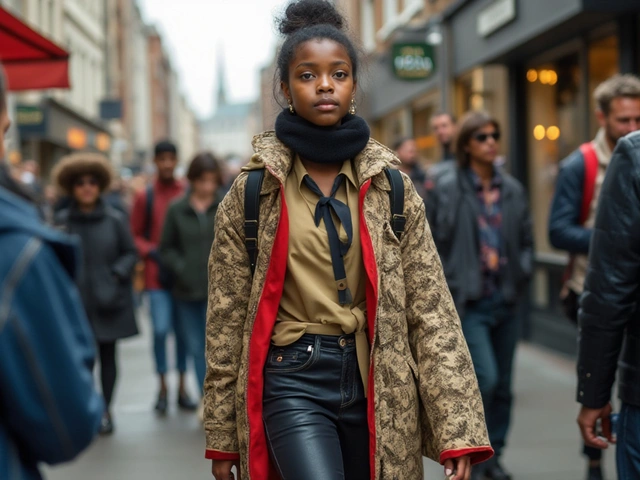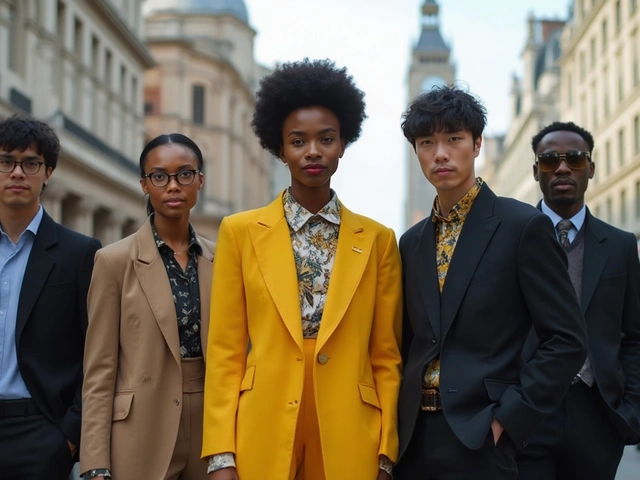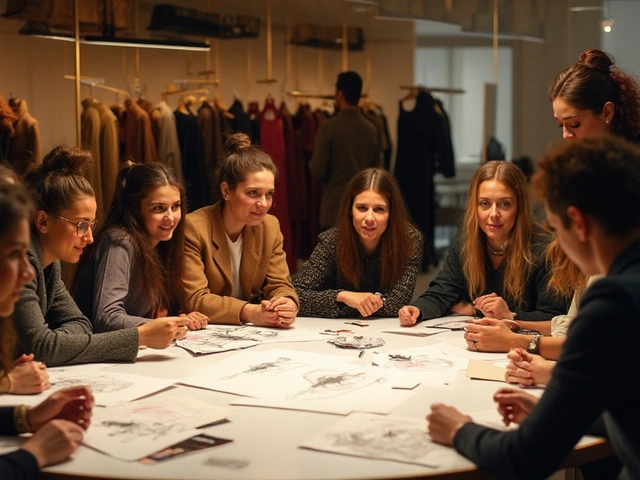If you pay attention to today's fashion week or scroll through the latest street style snaps, it's easy to spot the same patterns popping up from Tokyo to Paris. Clean lines, neutral colors, and easy shapes—this isn't just a fluke. It's what many call International Style, a way of dressing that borrows from everywhere and nowhere all at once. No matter where you're from, odds are some piece of your outfit traces back to this movement.
Unlike trends that come and go, International Style focuses on outfits that work anywhere, anytime. It mixes comfort with a sharp look—think tailored pants with a soft tee—or sleek, simple dresses that work from a meeting in New York to a gallery opening in Berlin. And here's the part people love: if you get the basics right, you’ll always look put together, even if you just rolled out of bed.
- What Exactly is International Style?
- A Quick History of Global Influence
- Defining Features of International Style
- Key Designers and Icons to Know
- How to Add International Flair to Your Look
- Why This Style Keeps Coming Back
What Exactly is International Style?
International Style is a term that started out in architecture and art back in the 1920s and 1930s, but it found its place in the fashion world too. The idea is simple: keep things minimal, practical, and flexible, so clothes work for more people, not just a specific culture or location. It’s all about making fashion that can cross borders without missing a beat.
Instead of loud prints or detailed traditional patterns, International Style sticks to clean lines, solid colors, and shapes that flatter lots of body types. Most pieces have little decoration—think blazers, slim trousers, or crisp shirts. This style actually took off in the late 20th century when designers started looking for a way to break free from the rules of classic European and American fashion.
Here’s a quick breakdown of what you’ll usually see in International Style:
- Neutral color palettes—lots of black, white, beige, navy, and gray
- Simple shapes and relaxed fits—nothing too tight or too baggy
- Quality fabrics like cotton, wool, linen, or silk
- Layering pieces that work together in different weather or cultures
If you want numbers, check this out: a 2023 report from the Business of Fashion showed that minimalist and globally-inspired collections made up 37% of mainstream brands’ new releases. This shows just how much International Style has become the go-to for both designers and shoppers.
| Key Feature | How It Shows Up in Fashion |
|---|---|
| Neutral Colors | Black turtlenecks, beige blazers, gray slacks |
| Simple Silhouettes | Straight-leg jeans, shift dresses |
| Quality Fabrics | Wool coats, silk tops, cotton tees |
| Adaptability | Outfits mix and match easily, work in different climates |
The bottom line? International Style isn’t about looking flashy or standing out in a crowd. It’s about pieces you can wear pretty much anywhere and still fit right in—whether you’re at a business meeting or just grabbing coffee down the street.
A Quick History of Global Influence
Fashion hasn’t always looked this unified across the globe. If you look back, each region dressed in its own way. You had Paris dominating haute couture in the early 1900s, London rebelling with punk in the 70s, and Tokyo shaking things up with streetwear in the 90s. But as travel, media, and the internet broke down barriers, styles started blending—quickly.
The real jump into the international style scene happened after World War II. Designers in Europe wanted a look that left behind the frills and fuss of older trends. Christian Dior’s "New Look" sparked a change, but soon, Swiss architect Le Corbusier and the Bauhaus movement were inspiring not just buildings, but clothes too—favoring sharp lines and function over decoration.
By the 1960s, Italian tailoring, American sportswear, and French minimalism started showing up in the same outfits. Fast-forward to today: you’ve got Korean streetwear, Scandinavian minimalism, and African prints all turning heads on the same runway. It’s a mix because of global travel, social media, and designers working across continents.
- 1960s: Mod fashion in London and simple suits from Milan go global.
- 1980s: Japanese designers like Rei Kawakubo and Yohji Yamamoto shake up Paris Fashion Week with loose, minimalist looks.
- 1990s: Hip hop in America and minimalism in Northern Europe start showing up worldwide.
Just to make this more concrete, here’s a look at how world cities drove major style shifts:
| Decade | City | Influence |
|---|---|---|
| 1950s | Paris | Couture and shape-defining looks |
| 1960s | London | Mod, youth-driven style |
| 1980s | Tokyo | Avant-garde and minimalism |
| 2000s | New York | Streetwear and everyday chic |
| 2010s | Seoul | Mixing tech, street, and luxury |
What’s key: fashion today is shaped by constant cross-pollination. Most of our closets probably have pieces inspired by at least two or three different countries. That’s the whole idea behind this global trend—grabbing what works from anywhere, and making something new.
Defining Features of International Style
When people first hear about International Style in fashion, they might think it’s just about mixing cultures. That’s only half the story. This look is about stripping things down to what works anywhere—outfits that feel right in any city without screaming for attention. It all boils down to a few clear ideas that make it so recognizable, yet hard to pin to a single country or era.
First, minimalism is huge. Forget busy logos or flashy prints. Instead, International Style goes for clean lines, solid colors, and shapes that make sense on most body types. Black, white, beige, and navy rule the color game here—they’re easy to mix and make outfits look expensive, even if you’re not buying luxury labels. The focus is on fit and balance, not decoration.
Next up, quality over quantity. This style doesn’t mean filling your closet with tons of clothes. On the contrary, it encourages people to buy fewer pieces that last longer. Fabrics like wool, cotton, and linen come up a lot. They breathe, they hold their shape, and they just feel better on the skin. This is part of what turned the international style into a mainstay in places where fast fashion is falling out of favor.
Another thing you’ll notice: gender-neutral vibes. A lot of International Style icons started blurring the lines between men’s and women’s wardrobes years ago. Think oversized blazers, relaxed-fit trousers, and shirts that anyone could pull off. Even major brands now offer collections that aren’t tied to a specific gender, making it easier for everyone to join in.
Let’s talk integrity. International Style leans into honest design. If a pocket exists, it’s for use, not just for show. Shoes are built to walk city blocks, not just make an entrance at a party. Accessories—if used at all—tend to be sleek and functional, like a simple watch or a sturdy tote bag. There’s a reason busy people and travelers love this style: less fuss, more action.
If you want a cheat sheet, here’s what to look for:
- Solid colors and no loud patterns
- Simple silhouettes: straight cuts, relaxed fits
- High-quality, breathable fabrics
- Subtle or no branding
- Functional design details (real pockets, sturdy zippers)
That’s how International Style keeps it timeless and versatile—smart, calm, and always ready for what’s next.
Key Designers and Icons to Know
When it comes to international style, a few big names always come up in the conversation. These designers and icons helped turn global influences and minimalist looks into the everyday clothes you see now, both on the runway and in stores.
Mies van der Rohe and Le Corbusier didn’t just change architecture—they shook up fashion sensibilities too. Their love for simplicity and clear structure inspired designers like Yves Saint Laurent, who made the tuxedo for women a global staple. Giorgio Armani followed, giving us relaxed suits that work everywhere, from Milan to Tokyo, perfect for both men and women who want to keep things simple but sharp.
Another giant in this space is Jil Sander, sometimes nicknamed the “Queen of Less.” Her approach is all about neutral colors and fuss-free outfits you can wear across different cities and cultures. Calvin Klein brought his take to American closets, mixing minimalist lines with easy-to-wear denim and underwear that became must-haves.
Japanese designers also left a major mark. Issey Miyake’s pleated designs mix tech with tradition, bridging East and West. Rei Kawakubo of Comme des Garçons flips expectations with designs that almost look like wearable art—unconventional but still grounded in the global move toward modern, pared-down style.
On the icon front, people like Audrey Hepburn turned “less is more” into a lifestyle. Her plain black dress in "Breakfast at Tiffany’s" is still one of the most copied looks ever. Even today, influencers like Sofia Coppola and Phoebe Philo favor international style’s clean and adaptable approach, showing that this look isn’t going out of style anytime soon.
How to Add International Flair to Your Look
Want your style to feel less local and more global? You don’t need to buy a ticket to Milan or Tokyo. Adding international flavor is easier than most people think—and it doesn’t mean turning your closet upside down. Here’s how you can do it, starting right where you are.
First, mix up your basics. The international style works because it’s all about clean, fuss-free pieces you can swap and layer. Go for a simple white button-down (French staple), wide-legged pants (huge in Japan), and sharp sneakers (a hit in South Korea). Notice how these elements cross borders? That’s the whole vibe.
- Neutral colors like black, navy, white, and beige work in nearly every city and give that effortless, everywhere look.
- Minimalist accessories such as a leather tote or metal-cased watch keep things modern and international—no loud logos needed.
- Layering is a key move. Think a loose blazer over a fitted T-shirt or a lightweight scarf. This shows off global influences without feeling costume-y.
- Mix up textures: denim, linen, and wool are used worldwide. Try a linen shirt with wool pants or a denim jacket over a crisp cotton dress.
If you want a little data, here’s something fun: according to a 2024 report from Statista, 38% of Gen Z shoppers in Europe and North America say global fashion trends are their top style inspiration. That number jumps up to 52% in urban areas. So, if you feel like everyone’s suddenly wearing the same stylish sweaters in London and Seoul, you’re not imagining it.
| Popular International Pieces | Origin | Where You'll See It |
|---|---|---|
| Simple Blazer | Italy | Everywhere from streetwear to boardrooms |
| White Sneakers | Germany/France | City centers worldwide |
| Wide-Leg Trousers | Japan | Fashion hotspots, busy subway stations |
| Linen Shirt | France, Mediterranean | Summer festivals, coastal cities |
Here’s a quick tip: Spend a few minutes scrolling through Instagram accounts of designers like Phoebe Philo or street style photographers in cities like Copenhagen or Seoul. You’ll spot the same easy lines and simple shapes repeated with small twists. That’s the international look in action.
Shopping for new stuff? Try brands like COS, Uniqlo, or Zara, where global trends meet practical wear. Pick up one or two things you can wear with stuff you already own. You want pieces that get along, not fight for attention. And if your budget is tight, local thrift shops or vintage stores are goldmines for international pieces at a fraction of the price.
The goal here isn’t to copy every runway trend. It’s about building a wardrobe that feels modern, travels well, and works on any street—at home or far away. Mix, match, and tweak as you go. That’s what makes your style truly international.
Why This Style Keeps Coming Back
If you ever wonder why the international style always finds its way back into the spotlight, it really comes down to how practical and versatile it is. People want their clothes to do more than sit pretty—they want them to last, fit in anywhere, and never really go out of style. That’s the secret sauce here.
Let’s look at some numbers. According to a 2024 survey from the Global Fashion Agenda, over 60% of shoppers say they're looking for outfits they can wear for years, not just a season or two. With minimal shapes and neutral tones, international style ticks all those boxes. You don’t need to fuss or overhaul your closet every year because the basics are always in. This saves time and a whole lot of money.
Fashion magazines like Vogue and Harper’s Bazaar keep spotlighting this trend because it bridges street style and luxury. From Milan to Seoul, influencers and designers keep coming back to it simply because it never looks out of place.
- It makes travel and packing easy—you never stick out for the wrong reasons.
- It works for work, events, or casual weekends without ever feeling off.
- It's perfect for mixing old and new pieces. You could wear a new jacket with jeans you've owned for five years.
Check out how international style trends have held up across the decades:
| Decade | Main Style Features | Popularity Level |
|---|---|---|
| 1960s | Boxy cuts, minimalism, calm colors | Moderate |
| 1980s | Tailored suits, sharp lines, global designer collabs | High |
| 2000s | Mix of old and new (retro vibes), focus on function | Rising |
| 2020s | Simple silhouettes, eco-fabrics, worldwide popularity | Very High |
One quick tip: If you want your style to last, invest in quality basics—like a crisp white shirt or clean jeans—instead of one-hit-wonder trends. These international style pieces never really fade, so you get more from your wardrobe year after year.





